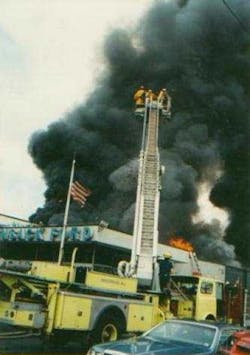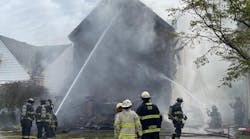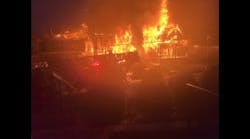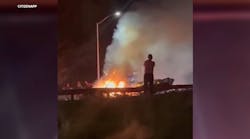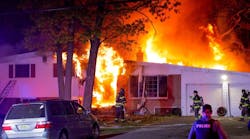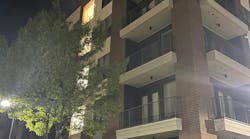As we approach the July 4th holiday period, two significant LODD incidents previously occurred during this time frame that hold a number of lessons learned related to command management, operations, building construction principles and building performance, fire behavior and the ever present dangers of the job.
Take the opportunity to learn more about these events, and expand your insights and knowledge base.
Take a moment to reflect upon the supreme sacrifice made by these heroic firefighters and the messages that lay within the pages of the incident case studies, reports and summaries.
There’s a lot of practical safety and operational information on these events along with a tremendous volume of information in the various text books on strategy and tactics, incident command and building construction.
Learn from the past so we don’t repeat it. Remember- NO MORE HISTORY REPEATING EVENTS!
The Hackensack Ford Fire & Collapse occurred nearly ten years AFTER another tragic LODD event involving a bowstring truss roof collapse; the August 2nd, 1978 FDNY Waldbaum’s Fire, Brooklyn, New York that took the lives of six FDNY firefighters.
- Street Smarts for Safety and Survival…………Stay safe.
- Additional Relevant Safety considerations, HERE and HERE
Twenty-Three Year Anniversary Hackensack Ford Fire and Truss roof collapse, Hackensack Fire Department. July 1st, 1988
Pause to remember our brothers who made the ultimate sacrifice twenty-three years ago, on July 1st, 1988 and the lessons learned from this event.
On July 1, 1988 Hackensack’s Captain RICHARD L. WILLIAMS, Lieutenant RICHARD REINHAGEN, Firefighter WILLIAM KREJSA, firefighter LEONARD RADUMSKI, and Firefighter STEPHEN ENNIS lost their lives at Hackensack Ford when a bowstring arch truss collapsed entrapping them in the area below.
The five firefighters were in the structure, a bowstring truss building, when the roof suddenly collapsed a 60-foot square section of the building’s wood bowstring truss roof collapsed, and an intense fire immediately engulfed the area. Williams, Kresja and Radumski were killed instantly, and four other firefighters escaped. Reinhagen and Ennis survived the initial collapse and found refuge in a tool room where they spent the next 13 minutes calling for help.. . despite heroic rescue attempts, succumbed to carbon monoxide poisoning. Approximately 90 minutes after the collapse, firefighters located the bodies of their fallen comrades.
Three (3) building factors contributed to the collapse of this bowstring trussed roof:
• Alterations that consisted of a heavy ceiling of cementitious material on wire lathe;
• Auto parts storage in the attic; and
• The Fire burned for a significant length of time and was well advanced prior to detection.
• This roof collapsed 35 Minutes after the initial units arrived.
Remember:
• CAPT. RICHARD L. WILLIAMS, Engine Co. No. 304
• LIEUT. RICHARD REINHAGEN, Engine Co. No. 302
• F/F WILLIAM KREJSA, Engine Co. No. 301
• F/F LEONARD RADUMSKI, Engine Co. No. 302
• F/F STEPHEN ENNIS, Rescue Co. No. 308
NFPA SUMMARY
Hackensack, New Jersey Fire Fighter Fatalities July 1, 1988
Five fire fighters from the Hackensack, New Jersey Fire Department were killed while they were engaged in interior fire suppression efforts at an automobile dealership when portions of the building’s wood bowstring truss roof suddenly collapsed. The incident occurred on Friday, July 1, 1988, at approximately 3:00 p.m., when the fire department began to receive the first of a series of telephone calls reporting “flames and smoke” coming from the roof of the Hackensack Ford Dealership.
Two engines, a ladder company, and a battalion chief responded to the first alarm assignment. The first arriving fire fighters observed a “heavy smoke condition” at the roof area of the building. Engine company crews investigated the source of the smoke inside the building while the truck company crew assessed conditions on the roof. For the next 20 minutes, the focus of the suppression effort was concentrated on these initial tactics.
During this time, however, little headway appeared to have been made by the initial suppression efforts, and the magnitude of the fire continued to grow. The overall fire ground tactics were shifted to a more “defensive” posture (exterior operation) and the battalion chief gave the order to “back your lines out.”
However, before suppression crews could exit form the interior, a sudden partial collapse of the truss roof occurred, trapping six fire fighters. An intense fire immediately engulfed the area of the collapse. One trapped fire fighter was able to escape through an opening in the debris. The other five died as a result of the collapse. This incident and several others before and since, provide important lessons to the fire service regarding the fire ground hazards of wood truss roof assemblies.
This NFPA Summary may be reproduced in whole or in part for fire safety educational purposes as long as the meaning of the summary is not altered, credit is given to NFPA and the copyright of the NFPA is protected.
Following is an excerpt from the New York Times article:
Demers contended that Chief Williams, primarily because of the volume of fire on the rooftop, should have ordered nine firefighters out of the garage within 7 minutes of his arrival. The order to pull out was given at 3:34 p.m., about 30 minutes after his arrival, the report said.
- “This radio message was not acknowledged by any companies,” the report said.
The roof collapsed at 3:36 p.m. Three firefighters were hit by burning debris and killed, four escaped, and two, Lieut. Richard R. Reinhagen and Stephen Ennis, took refuge in the tool room.
- At 3:39 p.m., Lieutenant Reinhagen began to radio his location and appeal for help, the report said.
In one of the major communications flaws cited by Mr. Demers at the fire scene, all departmental communications were transmitted on a single channel, or frequency. Consequently, Lieutenant Reinhagen’s appeals for help were intermingled with orders for deploying men and hoses and instructions to arriving companies.
- “You have to hurry, we’re running out of air,” Lieutenant Reinhagen said at 3:42 p.m.
Headquarters then radioed to Chief Williams: “Expedite on that, they’re running out of air.” The transcript did not show any response from Chief Williams.Over the next 6 minutes, through 3:48 p.m., Lieutenant Reinhagen made 10 more calls. None was answered. For three of the minutes, bells indicating depletion of his air tanks’ supply were ringing repeatedly. At one point, a civilian who overheard the ringing on a radio scanner called fire headquarters to tell officials of the noise.
At 3:49 p.m., the Lieutenant radioed: “Chief, this is Lieutenant Reinhagen. I’m still stuck back in the right rear of the building in the closet. We are out of air in a closet. We’re out of air.”
“What’s your location?” Chief Williams said. The response was inaudible and the Chief began ordering water from a truck.
At 3:50 p.m., the Lieutenant got the Chief directly and repeated that they were “stuck in a closet” and “out of air.”
- “Stuck in a closet?” Chief Williams asked.
Twelve seconds later, the Chief Williams asked: “Where you at?”
- “Right there in the closet,” came the response.
- Fourteen seconds later, Lieutenant Reinhagen radioed again: “Help. The right rear. Out of air. Anybody out there? Stuck in the closet, right rear. No air. Help.”
The Lieutenant was asked if he was on the first or second floor. “First floor, underneath the collapsed ceiling,” the Lieutenant said at 3:52 p.m. It was his last transmission. Firemen eventually punched a hole through an exterior wall about 10 feet from the tool room, but saw only a mass of flame, Mr. Demers said. The burning timbers were leaning against the tool room, he said, but neither fireman was burned.
Learn from the past so we don’t repeat it. Remember- NO MORE HISTORY REPEATING EVENTS!
Some Open Questions;
- What impact did the Hackensack Ford Fire & Collapse have upon you in your career?
- Were you aware of this event and its lessons learned prior to this posting?
- What do you feel you need to learn related to Building Construction, Fire Behavior or Strategy and Tactics related to various occupancies and construction types?
- What is you knowledge base on Truss Construction related to Timber Bow String or Engineered Structural Systems?
Additional References:
- NFPA REPORT, HERE
Other Resource Links:
- http://www.wusa9.com/news/columnist/blogs/2008/06/hackensack-ford-20-years-later.html
- http://query.nytimes.com/gst/fullpage.html?res=940DE3D6143FF931A357…
- http://www3.gendisasters.com/new-jersey/6534/hackensack-nj-fire-aut…
- http://www.nfpa.org/itemDetail.asp?categoryID=442&itemID=18676&;…;…
- Memorial Park, Hackensack, NJ (http://www.cyberonic.net/~mikef6/p0000120.htm)
Three Firefighters and Three Sisters Killed in Gloucester City, New Jersey Building Collapse during Fire Attack, Rescue Operation, July 4th, 2002
On July 4th, 2002 at 0136 hrs.,The Gloucester City Fire Department was dispatched to 200 North Broadway for a reported house fire. Responding units were advised that occupants may be trapped. First arriving units were on location in less than three minutes.
They found heavy fire on all exposures of a three-story multi-family dwelling and initiated a search for entrapped occupants. (Various reports from bystanders were at times conflicting regarding the number and location of victims). While providing an aggressive interior attack and rescue operation, an occupant was rescued from the dwelling. Due to the severity of their injuries they were unable to give direction regarding the whereabouts of any other occupants.
While all hands were operating by continuing an aggressive interior attack and rescue, a partial collapse of the structure occurred. An emergency evacuation signal was sounded and while that was commencing a further and much more substantial collapse occurred trapping eight firefighters inside the burning debris.
Additional specialized collapse rescue resources were requested, firefighter accountability was initiated and rescue efforts were intensified. Five of the eight trapped firefighters were rescued. Three of the eight gave the ultimate sacrifice in service to their fellow man. Unfortunately these three children did not survive. A total of nine victims were transported to area hospitals, one civilian and eight firefighters.
Remember:
- James Sylvester Fire Chief, Mount Ephraim Fire Department
Sylvester, 31, a 17 year veteran, was survived by his wife, who was pregnant with the couple’s first child - John West Deputy Chief, Mount Ephraim Fire Department
West, 40, a 23-year veteran, was survived by his wife and three children - Thomas G. Stewart III Paid Firefighter, Gloucester City Fire Department
Stewart, 30, a 13 year veteran, was survived by his fiancée and their son. Stewart publicly proposed to his girlfriend, hours before the fire while they watched the city’s fireworks from high atop a fire truck ladder at Gloucester City High School.
- NIOSH REPORT: Structural Collapse at Residential Fire Claims Lives of Two Volunteer Fire Chiefs and One Career Fire Fighter – New Jersey, HERE
- Philadelphia Inquirer Posting, HERE
- Everyone Goes Home Newsletter Article by Chris Collier, HERE
- New Jersey Division of Fire Safety LODD Report, HERE
SUMMARY
On July 4, 2002, a 30-year-old male volunteer fire chief, a 40-year-old male volunteer deputy fire chief, and a 30-year-old male career fire fighter died when a residential structure collapsed, trapping them, along with four fire fighters and an officer who survived. At 0136 hours, a combination fire department and a mutual-aid volunteer fire department were dispatched to a structure fire.
Local law enforcement radioed Central Dispatch reporting a fully involved structure with three children trapped on the second floor. The first officer on the scene assumed incident command and reported to Central Dispatch that the incident site was a three-story structure with fire showing and that people could be seen at the windows. Note: The female resident (survivor) was the person seen in the window.
The three children that were reported as being trapped did not survive and were later found in the debris. Additional units were requested, including a mutual-aid ladder company from a career department. Crews were on the scene searching for occupants and fighting the fire for approximately 27 minutes when the building collapsed.
NIOSH investigators concluded that, to minimize the risk of similar incidents, fire departments should;
• Ensure that the department’s structural fire fighting standard operating guidelines (SOGs) are followed and refresher training is provided
• Ensure that the Incident Commander (IC) formulates and establishes a strategic plan for offensive and defensive operations
• Ensure that the incident commander (IC) continuously evaluates the risk versus gain during operations at an incident
• Ensure that a separate Incident Safety Officer, independent from the Incident Commander, is appointed
• Ensure that fire fighters conducting interior operations (e.g., search and rescue, initial attack, etc.) provide progress reports to the IC
• Ensure that accountability for all personnel at the fire scene is maintained
• Ensure that a Rapid Intervention Team (RIT) is established and in position
• Ensure that the officer in charge of an incident recognize factors (e.g., structural defects, large body of fire in an old structure, etc.) when analyzing potential building collapse
• Ensure, when feasible, that fire fighters should respond together, in one emergency vehicle, as a crew
Additionally, municipalities should consider
• Establishing and maintaining regional mutual-aid radio channels to coordinate and communicate activities involving units from multiple jurisdictions
In order to minimize the risk of similar incidents, the New Jersey Division of Fire Safety identified key issues that must be addressed and remedies that should be implemented within all departments.
1. FACTOR: There appears to be a disconnect between career and volunteer personnel in the Gloucester City Fire Department (GCFD). Many personnel expressed the concern that the GCFD operated as separate fire departments rather than as one.
REMEDY: It is essential that all firefighters put individual differences aside in order to work together successfully as a team to achieve their common goal of saving lives and property.
2. FACTOR: The GCFD, faces a common dilemma associated with combination fire departments: staffing levels may be unpredictable depending on how many volunteers are available to respond to any one incident. This unpredictability can result in insufficient staff to perform required tasks until additional staff arrives.
REMEDY: Elected or appointed municipal officials need to make a commitment to the adequate staffing of the fire department and staffing levels must allow for compliance with the two-in / two-out provisions of the Public Employees Occupational Safety and Health (PEOSH) Standard 29CFR1910.134. The New Jersey Division of Fire Safety can provide assistance to the municipalities and provide examples of how this can be accomplished
3. FACTOR: Due to the limited number of firefighting personnel who arrived at this incident, all initial efforts were focused on the rescue of occupants. This postponed fire suppression operations until additional resources arrived. Because rescue and fire suppression operations were performed sequentially rather than simultaneously, the fire may have spread more quickly resulting in the early failure of the structure.
REMEDY: Sufficient personnel are critical to ensure that all necessary operations can be performed at the appropriate time. Furthermore, a continual size-up assessment must be maintained so that the Incident Commander (IC) can be kept aware of the conditions as the incident progresses. This continual size-up will allow the IC to modify the strategy and / or tactics as deemed necessary.
4. FACTOR: Although the GCFD was equipped with a thermal imaging camera (TIC), firefighters failed to utilize it for the initial search for victims. The TIC was also not used properly to analyze the scope of the incident and determine what tactics to employ.
REMEDY: Fire departments that possess TIC units should use them regularly during routine operations such as training, scene size up, search and rescue and structural fire fighting.
5. FACTOR: From the onset of operations, the Incident Management System (IMS) was not properly expanded as the incident progressed. Given the scale of this incident, the span of control quickly became too large for the IC to effectively manage and additional functions were not delegated to subordinates. Critical tasks such as safety and accountability were not effectively implemented.
REMEDY: N.J.A.C. 5:75 mandates that all fire departments utilize an IMS. It is a modular system, which allows the IC to apply only those elements that are necessary at a particular incident, and allows elements to be activated or deactivated as incidents escalate or decline. Fire departments are required to adopt written plans, or Standard Operating Guidelines (SOG’s) based on the IMS, to address different types of incidents. The NJ Division of Fire Safety distributed suggested SOGs upon adoption of this regulation and they continue to be available to all fire departments.
6. FACTOR: The GCFD did not assign a dedicated safety officer (SO) to observe operations and terminate potentially unsafe actions.
REMEDY: IMS regulations under N.J.A.C. 5:75 mandate the use of safety officers (SO’s) at all incidents. An SO is required to observe operations on the fire scene, identify next steps and order the correction of safety hazards to personnel. Given the scope of this incident, the IC should have assigned at least one SO.
7. FACTOR: The GCFD did not designate accountability officers to monitor each area of entry into the structure. Nor was a Personal Accountability Report (PAR) or roll sheet utilized to track personnel and monitor their functions. Therefore, the concept of accountability of personnel location, function, and time failed.
REMEDY: Although not enforceable at the time of this incident, the regulations for the NJ Personal Accountability System (NJPAS) under N.J.A.C 5:75 now require that fire departments utilize an accountability system. This system includes the designation of accountability officers and the use of PAR’s / roll calls, all within the framework of the IMS that is required to be utilized at all incidents. The NJ Division of Fire Safety is in the process of finalizing suggested SOGs and will distribute them to all fire departments when complete.
8. FACTOR: Although firefighters Sylvester and Stewart were equipped with Personal Alert Safety System (PASS) devices, they did not activate them prior to entering the structure. It should be further noted that their PASS devices were not automated; they had to be manually activated by the user. Firefighter West was not equipped with a PASS device.
REMEDY: PASS devices must be provided, used, and maintained in accordance with PEOSH regulations under N.J.A.C. 12:100-10 et seq. Although many departments still rely on PASS devices that must be activated manually, – devices that are acceptable by PEOSH regulations – they are not ideal because the firefighter must remember to activate the PASS device. For this reason, fire departments should strongly consider upgrading their SCBA to those employing automatic activating PASS devices.
9. FACTOR: The GCFD did not specifically designate the required personnel for the rescue of distressed firefighters through the establishment of Rapid Intervention Teams (RIT) or Firefighter Assist and Search Teams (FAST). Consequently, when the building collapsed, there was not a properly equipped team in place for immediate rescue operations.
REMEDY: IMS regulations under N.J.A.C. 5:75 require that fire departments utilize RIT or FAST to rescue distressed firefighters when operating in a hazardous atmosphere. The IC should request a RIT or FAST as soon as possible after dispatch to allow the team to arrive quickly.
10. FACTOR: Not all fire departments operating on the fire ground were communicating on the same radio frequency, which resulted in communication failures. Although, the Camden Fire Department (CFD) did have the capability to communicate on the GCFD “Fire 5” frequency they chose not to.
REMEDY: IMS regulations under N.J.A.C. 5:75 require that a communication system allow for inter-agency communication during mutual aid responses by providing a direct communication link between companies. Fire departments should work with other departments that are used routinely for mutual aid to ensure radio interoperability.
11. FACTOR: An emergency evacuation signal was sounded upon reports of a firefighter missing inside the structure before the impending collapse, however, the signal was never sounded at any other time prior to the collapse, nor was it sounded immediately after the collapse.
REMEDY: In the event an emergency evacuation becomes necessary and an emergency signal is required, N.J.A.C. 5:75 requires that fire departments utilize an emergency evacuation signal that is easily recognizable and distinguishable from all other fireground noises. The signal must be utilized when conditions on the fireground indicate an imminent and extreme risk to firefighters. At this time NJ DFS is finalizing a proposal that would establish a statewide emergency evacuation signal.
12. FACTOR: During this incident, fireground conditions were not properly analyzed, which led to the failure to recognize an impending building collapse.
REMEDY: Firefighters and officers need to learn the warning signs and causes of building collapses. Often following a collapse, as was the case with this incident, personnel on the scene report that the structure collapsed “without warning”. However, this is usually not the case; the reality is that the IC and firefighters simply failed to identify the indicators that were present prior to the collapse.
13. FACTOR: After removal of all victims, the remaining structure was demolished and the incident scene was cleared of all debris within 48 hours of law enforcement concluding their origin and cause investigation. This prevented a thorough assessment of the remaining structure in order to identify the cause and contributing factors of the collapse.
REMEDY: A protocol should be adopted to ensure that fire scenes are secured in a manner that not only allows for public safety, but also prevents immediate demolition. This will provide agencies with an opportunity to conduct any investigations that may be necessary.
14. FACTOR It was difficult to gauge the amount of training for all GCFD personnel due to insufficient record keeping. Although it was determined that the GCFD firefighters and officers met the minimum regulatory training requirements, many members did not possess a great deal of supplemental training with regard to structural firefighting. Additionally, the volunteer firefighters and officers often did not attend the scheduled departmental drills and rarely trained with the career personnel despite having frequent opportunities to participate.
REMEDY: Standards such as NFPA 1500 recommend that fire departments establish a regular training and education program that is commensurate with the duties and functions that firefighters are expected to perform. Additionally, proper record keeping is essential to certify that all personnel have received both required and supplemental training or education.
15. FACTOR: Qualifications of volunteer officers were difficult to judge and there were serious concerns voiced by the career members of the department regarding the suitability of some of the volunteer officers. This resulted in a lack of confidence by several career personnel in the volunteer officers and reluctance to take direction from them.
REMEDY: In addition to the NJ DFS requirement that all fire service supervisors obtain incident management certification; municipal officials need to establish uniform minimum qualifications for fire officers in order to ensure the effective provision of fire suppression services to the public. The NJ DFS recently adopted voluntary fire officer standards and will be developing a training curriculum to meet those standards.
16. FACTOR: It was not possible to determine if a smoke detector inspection was conducted in the building after a change in occupancy in October of 2001 as required by the NJ Uniform Fire Code. The city’s housing department, who has the responsibility for these inspections, was unable to provide documentation of such an inspection to either the Division of Fire Safety or to the Camden County Prosecutor’s Office. It was not clear whether smoke detectors were activated during this fire incident.
REMEDY: It is recommended that the responsibility for smoke detector inspections be transferred to the fire department to ensure complete and documented inspections.
Additional Link on Bowstring Truss Safety Considerations;
